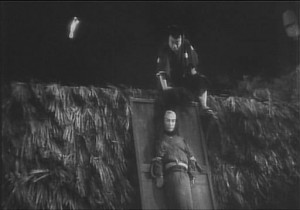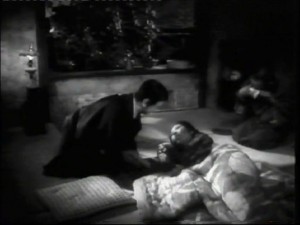The following was commissioned by and written for Asia’s 100 Films, a volume edited for the 20th Busan International Film Festival (1-10 October 2015). — J.R.
THE STORY OF THE LAST CHRYSANTHEMUMS
Though not the best known of Kenji Mizoguchi’s period masterpieces, this 1939 feature is conceivably the greatest. (For me the only other contender is the 1954 Sansho the Bailiff.) And according to film analyst Donald Kirihara in his book Patterns of Time: Mizoguchi and the 1930s (The University of Wisconsin Press, 1982), Mizoguchi himself regarded it “as a creative turning point in his career”. A film set in the 1880s that lasts 142 minutes and contains only 142 shots, it resorts to the more rapid editing style of Hollywood only when Kabuki performances are featured.
The plot, which oddly resembles that of the 1950s Hollywood musical There’s No Business Like Show Business, concerns the rebellious adopted son of a theatrical family devoted to Kabuki (Kiku, played by Shôtarô Hanayagi in his film debut) who leaves home for many years, perfects his art, aided by a young working-class servant who loves him but also dares to criticize his acting (Otoku, played by Kakuko Mori), and eventually returns. Apart from the highly charged and adroitly edited Kabuki sequences, the film is mainly constructed in extremely long takes, and an intricate rhyme structure between two time periods is developed by matching camera angles in the same locations. The massive sets designed by Hiroshi Mizutani are central to this visual plotting, especially when they block or deliberately overwhelm significant parts of the action. This is especially evident in the justly celebrated sequence, both lengthy and complex, recounting the first meeting of Kiku and Otoku, where the camera from a very low angle accompanies their extended progress down a road, stopping only when they do to buy a wind chime, and then continuing slightly past them when they stop a second time (when Otoku critiques Kiku’s acting). An even more radical example of Mizoguchi’s mise en scène occurs shortly afterwards, in the scene in which Kiku is banished by his father, this time filmed from a very high angle, where major parts of the action are kept offscreen.
Never before or since (apart from The 47 Ronin) has Mizoguchi’s refusal to use close-ups been more telling, and the theme of female sacrifice that informs most of his major works is given a singular resonance and complexity here. Demonstrating an uncanny mastery of framing and camera movement, the film also has a complexity of characterization that’s shown with sublime economy.


